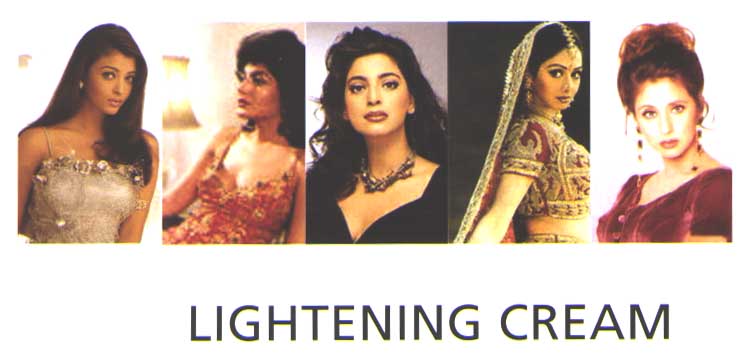T
E
X
TB
Y
J
A
S
M
I
N
E
M
I
R |
A PERUSAL OF THE BEAUTIFYING PRODUCTS ON THE SHELVES AT
DRUG STORES REVEALS MUCH ABOUT THE SURROUNDING COMMUNITY.
Case in point: on display at the
drugstore on the main drag of Jackson Heights, Queens one will find a
dizzying array of Ayurvedic and homeopathic cleansers, lipstick in every
shade (of red), kohl eyeliner in every shade (of black), and, shelf upon
shelf of creams that guarantee a transformation of the consumer's brown
skin into any shade (of white). Marketed to the local South Asian
community, these products reflect less an urge to assimilate into white
American society than the retention of a pervasive cultural preference in
South Asia for fair skin.
In India, 60% of all beauty products sold are skin lightening agents.
Women use at home treatments, such as Fair and Lovely Lightness
Cream—India's best-seller—as nightly rituals and to supplement more
intense bleaching treatments performed in salons. Damaging to the skin
over a prolonged period, these harsh ammonia treatments sting a bit on
application, but they produce the desired look: a skin tone "one to three
shades" lighter than natural. Soaps with added sunscreen, like the popular
International
LUX brand, advertise protection not from
the damaging and potentially skin cancer-inducing effects of the sun, but
from its "darkening effect." The soap promises to give users the
confidence to "venture out in bright sunlight and say: who's afraid of the
sun!"
Discrimination on the basis of skin color is part of a larger system of
caste hierarchy within India. Arguably, skin tone affects women's
marketability for both marriage and white collar employment, a reality
which has increasingly come under attack by advocates for women's rights,
as well as activists for social equality in general. For American-born
women of South Asian descent, a demographic whose image is both glorified
and commodified by the faddish interest in "Bollywood" style, this
question of skin tone arouses contentious debate. For some, the fair skin
preference reflects a legacy of colonialism on the subcontinent, in which
white skin was associated with European oppression but also power, access
and social control. By this logic, the preference for fair skin among
South Asians is a marker of post-colonial self loathing. Others see it
simply as an aesthetic preference, such as Western society's blonde hair
and a thin body. And who wouldn't want to embody a beauty ideal?
However, a Saturday afternoon stroll through
Sephora rush hour reveals that it is not
just South Asian women who are buying Lancome, Christian Dior and Estee
Lauder's new glossy packaged versions of skin bleaching agents. Their
"technological breakthrough skin brightening microcapsules" are selling
broadly to Asians and non-Asians alike. Which raises the question, with
half the white population tanning to achieve an 'I just returned from my
resort vacation in St.Tropez' look, why would achieving a greater pallor
be desirable? Perhaps what is really for sale on the shelves of the
Sephora store is a commodity more coveted than either the porcelain
complexion or bronze tan (with all that these skin tones imply).
Armed with the requisite disposable income, the consumer can buy the
luxury of self-transformation, searching for her best possible self, and
redefining "best" on a seasonal basis. With beauty treatments, as with
clothing style, artifice and experimentation are ends in themselves and
signify the luxury of choice.
For those who want them, skin lightening products have arrived at nearly
every price point on the spectrum, from 99 cent soap to $140 night cream.
Apparently, beauty trends themselves shift over time, but the ability to
indulge in them never goes out of style.
©
IN MAGAZINE, 35 Howard St. New York, NY
10013 |
|
